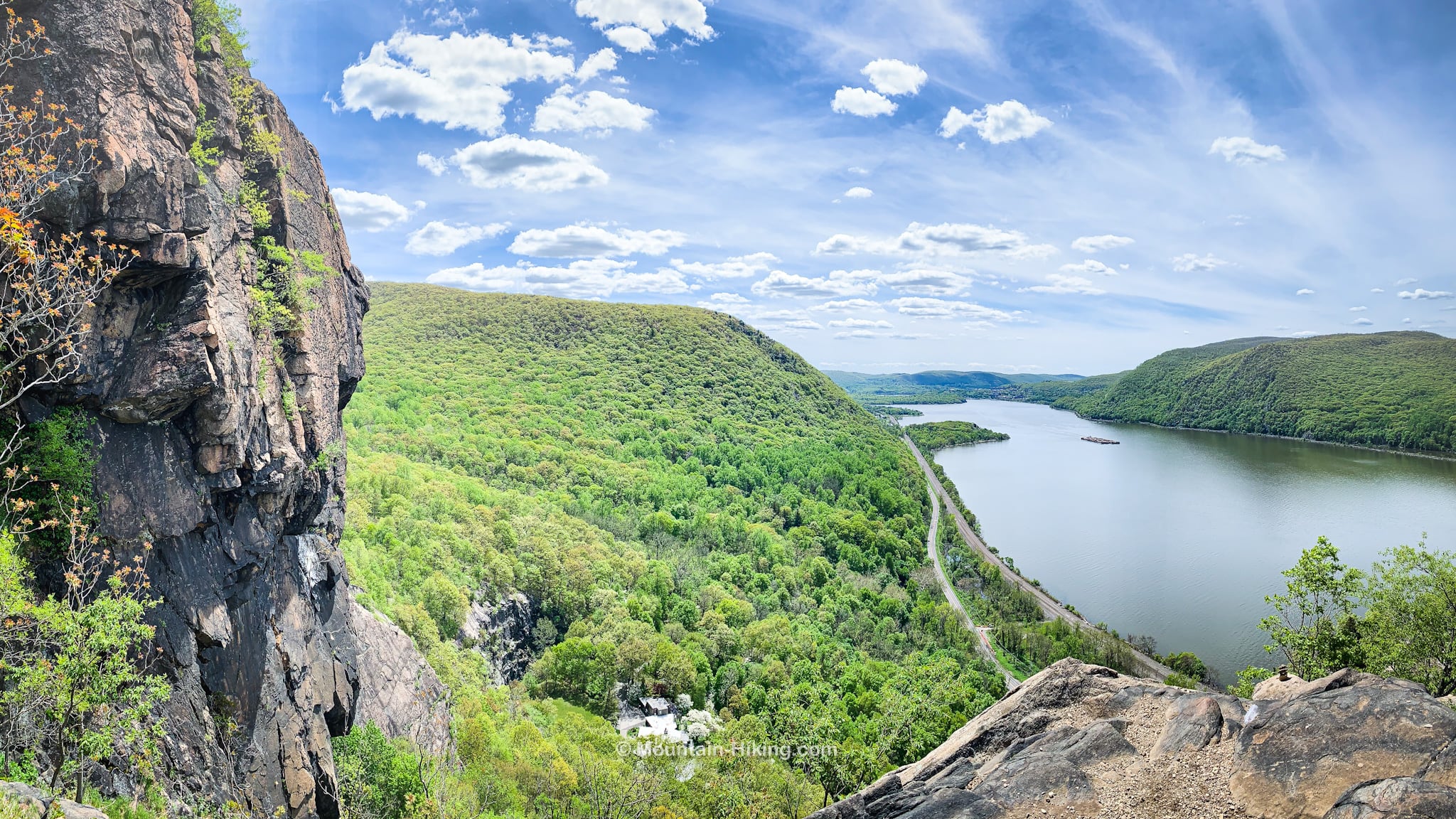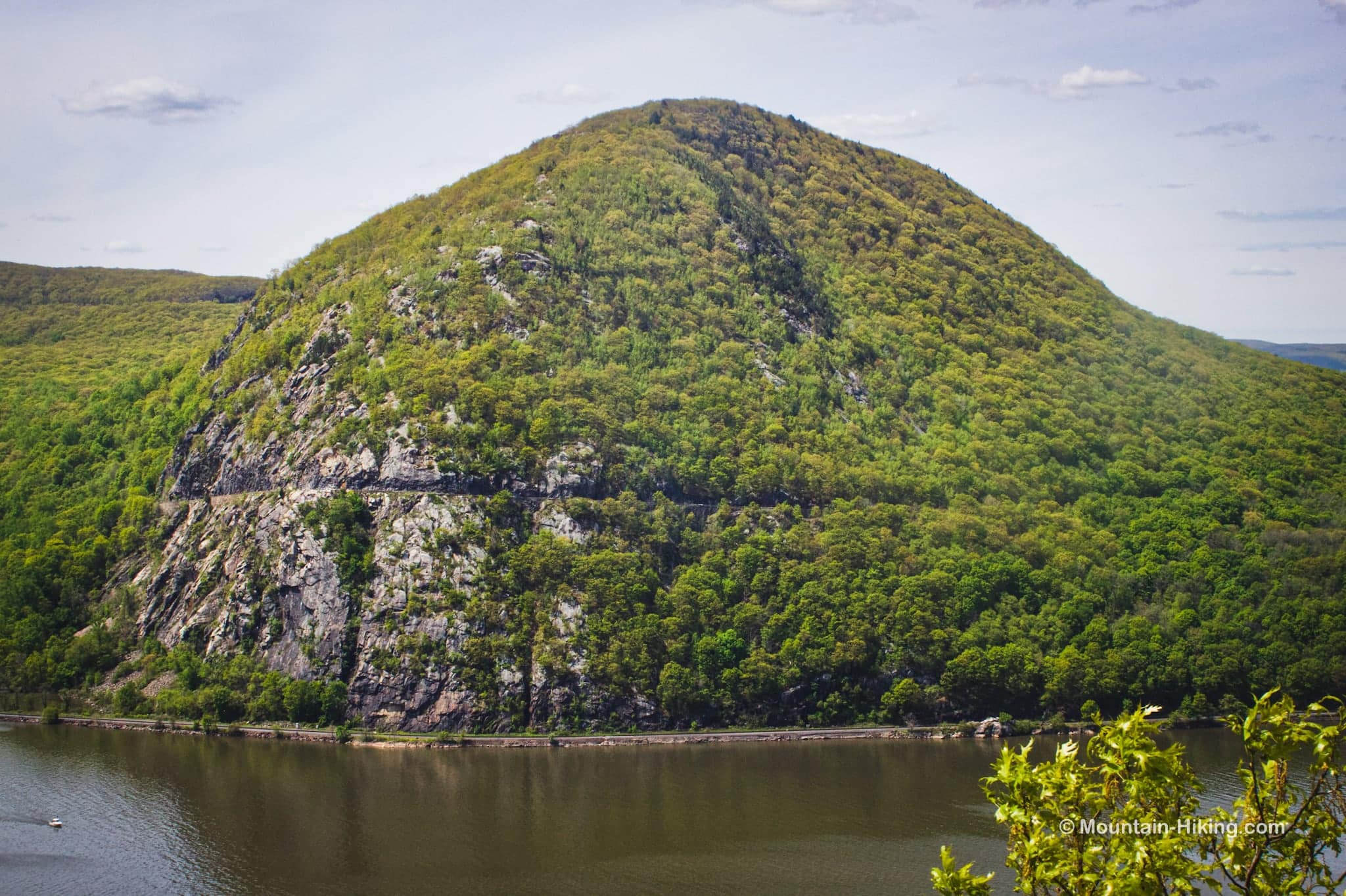The Hudson Highlands
Easy accessibility from New York City and New Jersey and famously panoramic views have made the Hudson Highlands a key destination for day hikers
Discover the Hudson Highlands’ spectacular mix of forested hills, rocky peaks, and water views. Whether you’re a seasoned hiker or a novice explorer, these detailed trail guides to hiking the Hudson Highlands provide comprehensive information, tips, and recommendations that cater to every skill level.
Hudson Highlands summits are often broad, exposed rocky outcroppings, and many trails here offer sweeping, dramatic, highly-photogenic views like this…
The Hudson Highlands are very popular. In the summer and fall, every trailhead and parking area is packed. Especially on weekends and holidays, you’ll need to arrive early-early to ensure a spot.
Hike The Hudson Highlands
Tap into the serene tranquility and unparalleled beauty that is synonymous with the Hudson Highlands hiking experience.
Hudson Highlands East

- Breakneck Ridge
- Anthony’s Nose
- Bull Hill (Mount Taurus) Full Loop
- Bull Hill (Mount Taurus) Short Loop — coming soon
- Northgate / Cornish Estate Ruins
- Mount Beacon Fire Tower via Casino Trail
- Mount Beacon & Schofield Ridge Loop — coming soon
- Fishkill Ridge — coming soon
Hudson Highlands West

- Storm King Mountain
- Pine Swamp Mine in Harriman State Park
- Schunemunk Mountain
- Bear Mountain — coming soon
- Popolopen Torne — coming soon
- West Mountain — coming soon
- Doodletown — coming soon
Hike Safety
Some quick notes on safety…
- Unlike the trail blazes in the Catskills and Adirondacks, Hudson Highlands blazes are non-reflective. If you don’t have a headlamp in your pack, make sure you’re off these hills before dark.
- In the warmer months, keep an eye out for rattlesnakes.
- Always pack The 10 Essentials.
Best Way to Navigate the Hudson Highlands
To navigate these breathtaking mountains, I use NYNJTC’s maps. These are the most reliable hiking trail maps of the area — they’re made by the same people who make the trails!
You get can get paper and digital copies here:
Read how to use the digital versions in 12 Best Hiking Apps.
Hiking Emergencies
In case of an emergency, NYS Park Police can be reached at (845) 889-8866.
Geologic History of Hudson Highlands
The Hudson Highlands rock bed dates from the Precambrian. The rock here was formed in the very earliest days of the Earth’s history. More recently, during successive ice-ages, the highlands were ground out by mile-thick ice-sheets.
Approximately 20,000 years ago, the Hudson Highlands, like much of the northern United States, was covered by a vast ice sheet known as the Laurentide Ice Sheet. This massive glacial formation, extending as far south as Pennsylvania and as far west as the Missouri River, had a profound impact on the land’s geology.
As the ice advanced, it acted like a colossal bulldozer, reshaping the terrain, carving out valleys, and depositing sediments. The rugged landscape we see in the Hudson Highlands today is largely the result of the Laurentide Ice Sheet’s incredible erosive force.
When the climate began to warm around 13,000 years ago, the Laurentide Ice Sheet began to retreat. As the ice melted, it left behind a swath of debris that included boulders, gravel, and fine particles known as glacial till. It also filled valleys with meltwater, creating the characteristic fjord-like profile of the Hudson River.
Evidence of the ice sheet’s influence can be found throughout the Hudson Highlands, from striations on bedrock surfaces indicating the direction of ice movement, to erratic boulders deposited far from their origins. The ice sheet’s legacy can also be seen in the nutrient-rich soils of the area, which contribute to the diverse flora that hikers enjoy today.
American History in the Hudson Highlands
The Hudson Highlands played a vital role in American history. The area is prized for its strategic location on the Hudson River, and it held a pivotal position during the Revolutionary War.
General Washington’s Great Chain stretched across the Hudson River at West Point and was instrumental in thwarting British naval forces, preserving the American revolutionaries’ control of the Hudson River Valley.
West Point, now home to the U.S. Military Academy, is steeped in military tradition dating back to its establishment in 1802.
The Highlands also witnessed the development of the American Romantic movement with the advent of the Hudson River School of painters who were inspired by the region’s natural beauty.
The region’s industrial past is marked by remnants of old mines, such as those in the town of Cold Spring. These mines once yielded iron ore which was pivotal in the 19th-century industrial growth of the country.
The Hudson River’s role as a transportation hub further fostered economic development, solidifying the region’s place in the annals of American history.
Today, the Highlands are protected lands, dedicated to conservation and outdoor recreation but this rich historical context only adds to the depth of the hiking these peaks, connecting our modern lives with the past as we explore this remarkable landscape.
Scenic Hudson & the Birth of the Environmental Movement
The Hudson Highlands are extremely biodiverse. Biomes range from brackish tidal marsh and mudflats to pitch pine-oak-heath rocky summit forests, swamps, and rocky grasslands. The area is also extremely popular for birding.
Founded by local citizens and hikers in 1963 — to stop an industrial project that would have turned Storm King Mountain into a ConEd hydroelectric plant — Scenic Hudson is widely credited with launching the modern grassroots environmental movement.
Today, with more than 25,000 supporters, Scenic Hudson is the largest environmental group in the region. Check out their list of 45 amazing parks dotted up and down the Hudson Valley.
Hike Well & Leave No Trace
Preserving the natural beauty of the Hudson Highlands is a shared responsibility, guided by the principles of Leave No Trace. These guidelines emphasize respecting wildlife, not disturbing vegetation, and carrying out all trash. It’s vital that hikers and visitors stay on designated trails to prevent soil erosion and protect local flora. Campfires are generally prohibited to prevent forest fires and safeguard the area’s ecology. Any evidence of human presence, such as litter, graffiti, or non-natural markers, should be avoided.
Please remember to hike thoughtfully.
- Stay on marked trails. Do your part to protect the surrounding ecosystem.
- Wear proper hiking gear such as hiking boots or sturdy shoes.
- Bring water with you, carry a trail map and make sure to leave enough time to complete your hike; the park is open from sunrise to sunset.
Please note that overnight camping and use of fire are prohibited throughout the park.
Get access to hyper-detailed trail guides, insider tips, and expert advice. Join a vibrant community of like-minded hikers, receive exclusive content, and embark on unforgettable outdoor adventures. Whether you’re a seasoned outdoor enthusiast or just starting out on your hiking journey, this website provides invaluable resources to help you explore the best trails in the Catskills, Adirondacks, Hudson Highlands, Berkshires, and beyond. Get access now to all content on this website instantly and enjoy unique supporter benefits.
Hardest Hudson Highlands Peaks (1)
Breakneck Ridge 1260’
Hudson Highlands
Fully Trailed
Scenic
Rugged and beloved, this is the toughest hiking mountain in the Hudson Highlands.
No. of Entries: 1
Difficult Hudson Highlands Peaks (2)
Schunemunk 1664’
Hudson Highlands
Fully Trailed
Scenic
A rugged, beloved peak with excellent views from two incredible ridges.
No. of Entries: 1
Bull Hill (Mount Taurus) 1420’
Hudson Highlands
Fully Trailed
Scenic
Beautiful, rugged mountain with fantastic views.
No. of Entries: 2
Moderate Hudson Highlands Peaks (3)
Fully Trailed
Scenic
Highest peak in the Hudson Highlands State Park. Very tall fire tower.
No. of Entries: 1
Storm King Mountain 1348’
Hudson Highlands
Fully Trailed
Scenic
Beloved mountain with some of the best scenic views in the Hudson Valley.
No. of Entries: 1
Anthony’s Nose 886’
Hudson Highlands
Fully Trailed
Scenic
Ever-popular hiking spot close to New York City.
No. of Entries: 1
Easiest Hudson Highlands Peaks (1)
Hogencamp Mountain 1335’
Hudson Highlands
Fully Trailed
A classic Harriman State Park mountain in Tuxedo, NY.
No. of Entries: 1